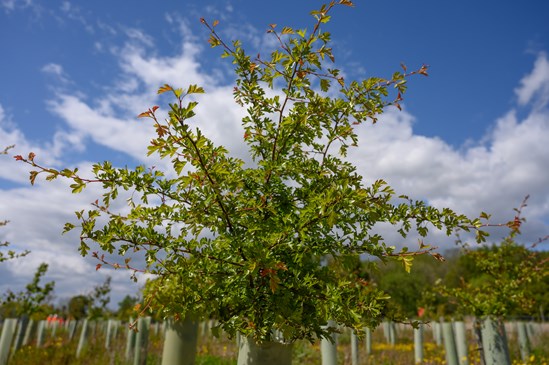As part of its extensive environmental programme, HS2 has today [Monday 5 July] announced that its contractors have now planted 700,000 trees and created over 100 wildlife sites along the route between the West Midlands and London. The wildlife sites represent a mix of different habitat types, including grassland, woodland, scrub and ponds, and are already havens for wildlife including birds, bats, barn owls, badgers, great crested newts, butterflies and dragonflies.
HS2 Ltd and its environmental contractors have designed tailored ecology plans that provide habitats for local wildlife and protected species including new badger setts, bat houses, bird boxes, reptile banks and bug houses, along with wildflower seeding, aquatic habitat creation and the reintroduction of native flora to help local wildlife populations thrive.
Up to 7 million trees will eventually be planted alongside the line from the West Midlands to London and HS2 will leave behind more than 33 square kilometres of new woodland, wildlife and river habitats - the equivalent of 23 new Hyde Parks lining the spine of the country.
In addition, HS2’s Woodland Fund has also allocated over £1.2m as part of a grant scheme managed by the Forestry Commission., with 213,000 trees already planted including 92 hectares of new woodland creation and 52 hectares of ancient woodland restoration. For example, a project at Avon Wood in Warwickshire has created a diverse new 11-hectare woodland within three miles of the new railway. More than 18,000 new trees have been planted there, with 30% of the woodland being oak, with the rest mainly made up of hornbeam, alder, beech, lime, holly and birch.
HS2 continues to progress with potential new schemes to be supported through the Woodland Fund, which could eventually support an additional 440 hectares of new native woodland creation as well as the restoration of 245 hectares of existing ancient woodland sites.
Mark Bailey, HS2’s Head of Natural Environment said:
“HS2’s Green Corridor is the largest single environmental project in the UK and these figures for tree planting and habitat creation demonstrate fantastic progress so far.
“We aim to leave behind habitats that can sustain healthy populations of UK flora and fauna, creating a network of bigger, better-connected, climate resilient habitats and new green spaces for people to enjoy.
“These new sites across Phase One show how the project is already improving landscapes around the new railway, ensuring HS2 protects the UK’s precious biodiversity.”
Richard Greenhous, Director of Forest Services, Forestry Commission said:
“As administrators of the HS2 Woodland Fund, we recognise and welcome the opportunities the HS2 Green Corridor brings to people, places and nature along its route. The activity supported by the Fund supports the reversal of habitat fragmentation, by creating native and extending ancient woodlands, and we will continue to work with HS2 and our Defra colleagues to ensure that the inevitable adverse impacts of the scheme will be more than counteracted by the legacy it creates. We therefore welcome these tree planting and habitat creation achievements as just the start of HS2 Ltd and landowners delivering this ambition.”
Every habitat site is designed specifically to support local biodiversity, to link up existing wildlife habitats and create ecological networks which help to protect, maintain and enhance biodiversity and allow species to move through the landscape.
Five examples of new habitats sites:
- In Warwickshire, Finham Brook was previously a short-grazed field with no flowers and very few invertebrates. Since 2018, HS2’s contractor Keystone Environmental has planted over 6,000 trees, created four new ponds and a new 35 metre reptile basking bank. The ponds are already being used by great crested newts, skylarks, barn owls, badgers, and dragonflies and butterflies in the summer months.
- Also in Warwickshire, near Stoneleigh Park, a ‘training pond’ for otters has been created so pups can safely learn anti-predator behaviour and foraging and hunting skills, before they take to the nearby River Avon. Artificial burrows and perches have also been established for kingfishers, while a bat house offers a mix of roosting sites to different species. Ecologists imagined it could be two years before it was occupied, but bats moved in within weeks.
- At South Cubbington Wood in Warwickshire, environmental contractor Five Rivers Environmental Contracting have planted 60,000 trees, along with species-rich grasslands. They have created seven new ponds designed for newts to breed in, as well as attracting other wildlife such as frogs, swallows, swifts and badgers. Like many of HS2’s new habitat sites, Cubbington has public rights of way, so local people are able to enjoy the habitats that have been created.
- At Bernwood in Buckinghamshire, an ecologically and historically valuable area includes a network of ancient woodlands that are home to a range of wildlife, including rare and important species like Bechstein’s Bat and the Black Hairstreak butterfly. HS2’s extensive tree planting here has linked existing woodlands to create new bat flight lines away from the railway corridor, and several green bridges will maintain connectivity across the railway and between habitats.
- In the Colne Valley, HS2 has revealed ambitious plans to create one of the largest areas of chalk grassland on the edge of the Chilterns in the Colne Valley. The site will receive a continuous supply of chalk from the nearby tunnelling underneath the Chilterns Hills until 2024, helping to establish over 127 hectares of new chalk grassland, woodland, wood pasture and wetland habitats. Field trials are currently in preparation ahead of final seeding, and planting of trees and shrubs in 2025.
ENDS

